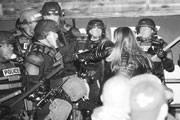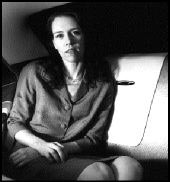IT WAS THE KIND of week you wouldn’t believe in a fictional story. Five nights of Mardi Gras “celebrations”—complete with pillaging worthy of Attila the Hun, naked girls, tear gas, and concussion grenades—culminated Tuesday night in a beating death. This all was followed mere hours later by the most powerful earthquake the city has experienced in half a century.
Where do we live? And what kind of a place is it? Sodom and Gomorrah? Are we turning into Los Angeles? It’s sunny enough.
One bizarre thing about an “act of God” such as the 6.8 quake is that there’s no one, besides God, to blame. And getting mad at God is at best fruitless and at worst, well, it’s probably better not to think about that.
On the other hand, the lack of serious injury or death is spooky. In my apartment alone, three large pieces of furniture tumbled, any of which could have crushed my little boy or me. Multiply my lone apartment by Seattle, Olympia, and everywhere in between, and it’s nearly unbelievable that this capricious act of nature stretching didn’t directly kill anyone.
But there’s no easy way to explore that situation. About the riots, however, people can’t stop blaming someone, everyone.
“Am I the only person around who thinks that the function of the police is to preserve order and protect the citizenry from undue harm?” This is a typical quote from a typical letter we received.
The finger-pointing doesn’t stop with the police chief’s decision during the worst of the rioting to stand back and watch. Saturday and Sunday mornings, police were accused of going too far to quell the crowds. Mayor Schell was attacked for sleeping through Tuesday night’s riot. Talk show callers blamed a lone black gang, the bars that got people drunk, and the system of joint covers.
Despite a search for simple answers, the most appropriate people to blame for the riots are the 4,000 or so who went down to Pioneer Square, looking to watch the show. You can argue the cops overreacted over the weekend, and maybe the bars served alcohol too long and too liberally, but this is another case—all too common in America—in which we’re trying to pinpoint a cause and effect that we can alter. Cancel future nightclub events, elect a new mayor, hire a new police chief—should we ban Heineken next?
The final answer is more complicated and maybe impossible to figure out. My apartment overlooks First and Yesler, and at any given moment on Friday, Saturday, or Tuesday night, I could see four, five, six fights—fists being thrown, chase being made, girls being wrestled to the ground. I’m shocked that only one person was killed; I still can’t believe no one was raped. I saw countless girls standing in the middle of crowds, responding to chants of “Show your titties!” by pulling their shirts off.
This was not a case, as some would like to think, of thousands of merry revelers’ being viciously attacked by one gang of marauding young (black) youths. Yes, there were black men (and one woman I saw) beating up whites, but also blacks and all colors were hitting back.
I’m not saying anyone asked to get beat up, but after five minutes in that crowd, they should have sensed something bad was going down. And that demands the question: Was that what they wanted? This speaks to something that the police, the mayor, and the bar owners cannot address. Why did so many people want to fight strangers in public? Why did so many women choose to get groped? And why, when it was clear that a blood lust snaked through the crowd, when traffic was stopped, cars were overturned, garbage cans thrown, windows smashed, why didn’t more people get out of the way and go home?
Maybe violence has always been a spectator sport.
On the following pages, we explore the fallout from both the riots and the quake. What do these events do to Mayor Schell’s chances of re-election? How will the riots affect the morale of rank-and-file cops who were forced to watch the mayhem from the sidelines? Another story explores the race factor of the riots. Turning to the quake, we answer the question of “Are seismologists good for anything?” and provide other earthshaking information, including an update of damage assessed by art galleries and rock clubs.
But if you’re looking for answers to the questions of what all of this means and will either disaster happen again, I don’t think there’s anyone here who can provide that.
AUDREY VAN BUSKIRK








